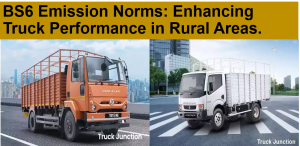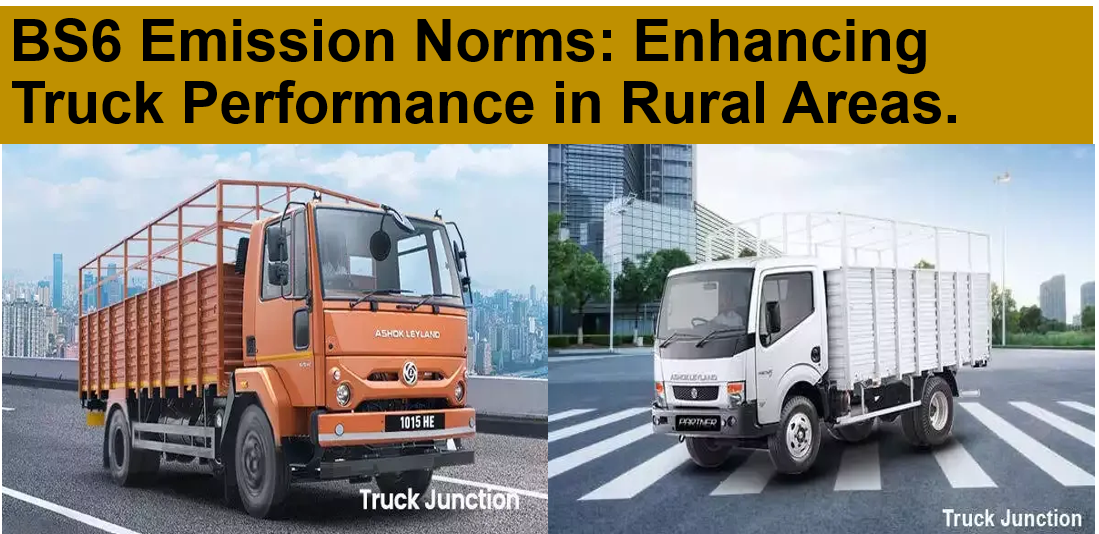Driving on roads in rural areas, trucks become the lifeline of rural regions. One such model, the Ashok Leyland Ecomet truck, has gained the reliability and trust of many users. Besides, commercial vehicles transport goods, connect communities and support local economies. 
Yet, they emit pollutants that harm the environment. That’s where BS6 emission norms come into play. This blog explores how BS6 emission norms enhance truck performance in rural areas.
Understanding the BS6 Emission Norms
BS6 emission norms imply that a commercial vehicle is safe for utilization. Moreover, users must go for trucks equipped with BS6 engines, reducing pollution. But, before that, users must know about this emission, which is essential for users. Let’s keep going.
First things first, what exactly are BS6 emission norms? You might have heard this term several times but couldn’t know about it. Besides, these emission norms are stringent regulations curbing harmful emissions from vehicles. In simpler terms, they make trucks cleaner and greener. But do you wonder what this has to do with rural trucking and its economy?
Reduced Air Pollution
The noticeable impact of BS6-compliant trucks in rural areas is reduced air pollution. Moreover, these trucks emit fewer pollutants, promoting cleaner air for rural regions.
Furthermore, with cleaner air, the health of rural residents is better protected. Reduced exposure to harmful pollutants leads to health issues.
Fuel Efficiency and Cost Savings
BS6-compliant trucks are not just about emissions; they also offer improved fuel efficiency. This is a boon for rural businesses that rely heavily on transportation. Further, the improved fuel efficiency means fewer trips. Also, fewer visits to the pump stations and lower operating costs for truck owners.
Additionally, the long-term cost savings associated with BS6 trucks are a significant advantage. Trucks demand slightly higher upfront costs. Their fuel savings make a smart investment for rural businesses.
Enhanced Engine Performance
The technology meeting BS6 emission norms resulted in the development of advanced truck engines. These engines offer better performance, ensuring that goods reach their rural destinations reliably and on time. Hence, rural businesses rely on trucks for handling heavy loads with greater ease, improving overall productivity.
Reduced Operating Costs
One of the significant advantages of BS6-compliant trucks is their improved fuel efficiency. Consequently, rural trucking businesses can cut down on their operating costs significantly. Moreover, you must know its way of working:
- Fuel Efficiency: BS6 engines are more efficient, meaning you get more miles per gallon.
- Reduced Fuel Expenses: With less fuel consumption, your fuel expenses decrease.
- Longer Maintenance Intervals: BS6 trucks often have longer service intervals, saving on maintenance costs.
Boosting Rural Commerce
Furthermore, these fuel-efficient trucks can help boost rural commerce. How? When operating costs go down, businesses can expand their reach. Additionally, consider these benefits:
- Increased Delivery Range: More miles per gallon mean more distant deliveries become cost-effective.
- Competitive Pricing: Lower operational costs allow businesses to offer competitive pricing.
- Market Expansion: Rural products can reach urban markets more efficiently.
Environmental Benefits
Let’s remember the environmental angle. BS6 trucks emit fewer pollutants into the air. Consequently, this cleaner air can lead to healthier rural communities. Furthermore, think about these advantages:
- Improved Air Quality: Reduced emissions mean better air quality for rural areas.
- Healthcare Savings: Healthier residents require fewer medical expenses.
- Tourism Boost: Clean, picturesque landscapes attract tourists, bolstering local economies.
The Road Ahead for Rural Transportation
As we look to the future, it’s clear that BS6 emission norms are here to stay. The Indian government is committed to reducing pollution and promoting sustainable transportation. Moreover, BS6 standards play a pivotal role in achieving these goals.
Furthermore, technology continues to evolve, bringing even more innovations to the trucking industry. Electric and hybrid trucks are promising an even greener future for rural transportation.
A Cleaner Tomorrow with BS6 Emission Norms
BS6 emission norms, also known as Bharat Stage 6. It represents the latest and strictest emission standards for vehicles in India. These norms were implemented to curb air pollution and promote cleaner transportation nationwide. But how do they affect trucks in rural areas?
Moreover, BS6 emission norms have ushered in a new era of cleaner and more efficient trucks. These norms require a significant reduction of harmful emissions.
It incorporates nitrogen oxides (NOx), particulate matter and hydrocarbons. This decrease in discharges is converting into substantial advantages for provincial regions.
In Conclusion
Hence, BS6 emission norms have ushered in a new era. It will promote cleaner, more efficient, cost-effective trucks for rural areas. These norms are regulatory requirements to comply with the emission standards. One such model, Ashok Leyland Partner, has brought a positive change, benefiting the environment and economy.
Additionally, the transition to BS6-compliant trucks is a step towards greener transportation. Moreover, it motivates towards a more sustainable future for rural transit.
It’s a win-win situation for truck owners, businesses, and the communities they serve. So, always remember a BS6-compliant vehicle contributes to a cleaner and healthier rural India.

